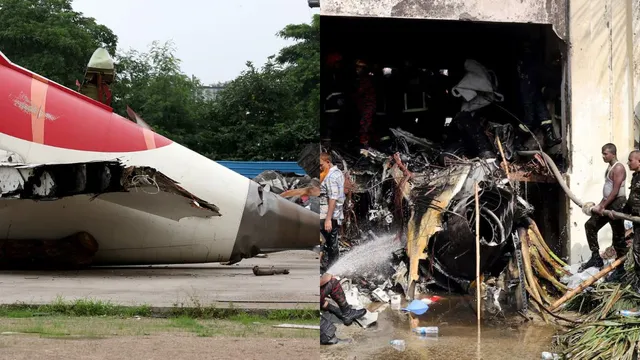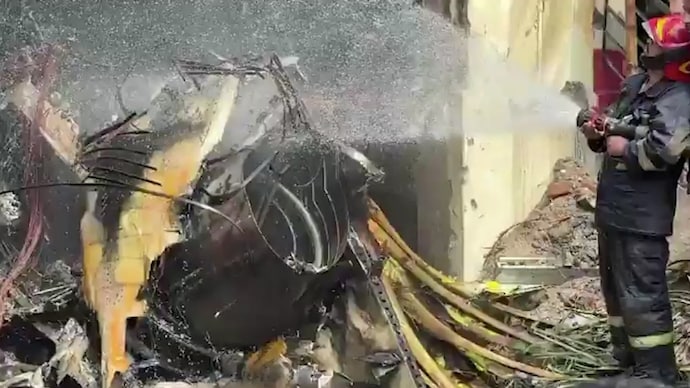Bangladesh is reeling from one of the deadliest aviation accidents in its history, after a Bangladesh Air Force F-7 BGI training jet crashed into a crowded school and college campus in the heart of Dhaka on Monday. The tragic incident claimed at least 19 lives—including children, teachers, and the pilot—and left more than 160 injured, sparking national mourning and urgent calls for a thorough investigation and improved air safety protocols.
In the days following the crash, hospitals across Dhaka have been overwhelmed not only by the physical toll but also by the emotional trauma suffered by survivors. Psychologists and trauma specialists are being brought in to assist young students who witnessed the horrifying incident or lost classmates and teachers. Several children remain in a state of shock, unable to process what happened. Mental health support camps have been set up near the affected school, offering free counseling sessions, while non-governmental organizations have stepped in to provide grief support for families. Authorities have also begun identifying children who may need long-term therapy to recover from the psychological scars of the disaster.
Media coverage of the incident has reignited public discussions over the necessity and safety of conducting military exercises or training flights near civilian areas, especially urban schools and hospitals. Although the Bangladesh Air Force has strict operating protocols, urban sprawl in cities like Dhaka has gradually eaten into areas once designated as safe zones. Aviation experts are urging a reassessment of flight paths, buffer zones, and risk mitigation strategies—particularly for training aircraft, which naturally involve higher risk due to pilot inexperience. Editors of leading newspapers have called for bold steps to prevent future tragedies, with op-eds stressing accountability, transparency, and systematic reform.
International aviation and military experts have also weighed in, suggesting that the tragedy in Dhaka should serve as a catalyst not just for Bangladesh but for all developing nations that operate mixed-use airspace. Rapid urbanization, limited emergency response time, and older aircraft platforms combine to create a dangerous formula when flights operate in proximity to dense civilian populations. Some countries have reviewed their own safety guidelines in the wake of this crash. There are calls within the Southeast Asian defense community for regional cooperation on military airspace management and emergency coordination, ensuring that civilian lives are safeguarded without compromising essential defense training.
As the nation begins the painful process of healing, plans are also underway for a national day of mourning. Children from across Bangladesh are writing letters of support to the affected school, while government officials have announced a scholarship fund in the names of the young lives lost. Across social media, the hashtag #NeverAgainDhaka is trending, symbolizing a collective will to ensure such a disaster is never repeated. Flags flew at half-mast at military installations and schools on Tuesday, while prayers and remembrances were held by leaders of all religious communities. Though grief hangs heavy, the response from ordinary citizens, rescue workers, and medical staff shines as a testament to Bangladesh’s enduring spirit in the face of unimaginable tragedy.

1. The Tragic Chain of Events: A Routine Flight Turns Deadly
Shortly after 1:00 PM local time, the F-7 BGI aircraft departed from the Bangladesh Air Force base as part of a scheduled training exercise. What followed was a devastating sequence: moments after takeoff, the aircraft reportedly experienced a technical malfunction. In a desperate effort to avoid a heavily populated urban sprawl, the pilot, Flight Lieutenant Mohammad Towkir Islam, attempted to maneuver away from residential blocks. Despite this act of courage, he lost control, and the jet plummeted into the premises of Milestone School and College in Uttara, a busy suburb of Dhaka with thousands of students on campus.
Eyewitnesses described a scene of chaos—an ear-shattering noise, followed by a massive explosion and an ominous column of black smoke. The aircraft reportedly struck a two-story section of the building housing lower grade classes, instantly setting off a fire and widespread panic as teachers and children rushed to safety. The pilot, who tried valiantly to regain control, succumbed to injuries after emergency crews tried to airlift him for advanced treatment.
2. Human Cost: An Outpouring of Grief
As rescue efforts unfolded, grim facts came to light. At least 19 people died, most of them schoolchildren and staff, while more than 160 sustained injuries ranging from burns to trauma from debris impacts. Dozens were taken to the National Institute of Burn and Plastic Surgery and Dhaka Medical College Hospital, with many in critical condition.
Dr. Bidhan Sarker, head of the burn unit at Dhaka Medical College and Hospital, recounted treating “children as young as 12, suffering from severe burns.” Several witnesses told of teachers bravely guiding students to safety, and scenes of parents scrambling across hospital wards searching for loved ones. Monday’s crash has left the nation mourning bright futures lost and a sense of security forever altered.
3. The Crash Site: School Turned Disaster Zone
The crash ripped a gaping hole through the ground and first floors of Milestone School and College’s campus. Photos and video from the site showed twisted wreckage, shattered glass, and fire-scarred walls, with thick smoke curling over a lawn reduced to scorched earth. The jet’s fuselage carved a direct path through classrooms, cafeteria, and administrative offices, causing massive structural damage and leaving parts of the building unsafe for future use.
Security personnel, firefighters, and two military platoons worked for hours to put out the blaze, carry out the wounded, and retrieve bodies. Ambulances and emergency vehicles shuttled victims to various medical facilities across Dhaka, while air force helicopters circled overhead to monitor the rescue operation and ensure no survivors were trapped in the rubble.
4. Heroism Amid Chaos: The Pilot’s Final Moments
Reports from military officials confirm that Flight Lieutenant Toukir Islam was flying his first solo mission on this aircraft type. Shortly after takeoff, the aircraft developed a major technical fault believed to be related to flight control failure. Control tower officials instructed him to eject, but at the low altitude and over dense population, safe ejection was impossible.
Military spokesperson Colonel Sami Ud Dowla Chowdhury described the pilot’s actions as “brave,” emphasizing that he was able to steer the plane away from the most congested parts of Uttara. His last-ditch effort directed the jet toward an open patch near the school campus; tragically, the attempt fell short, as the plane crashed through Block 7, housing the youngest students. Towkir Islam’s sacrifice has been widely mourned and commended for preventing even greater loss of life.

5. Emergency Response and Investigation
First responders arrived within minutes, with nine fire and rescue units deployed alongside ambulances and air force personnel. Medical teams triaged casualties, while school staff assisted firefighters and security forces in evacuating the surviving students and teachers to safety.
Government and military officials immediately launched a high-level investigation, forming a committee to analyze the cause of the disaster. Bangladesh interim Prime Minister Muhammad Yunus called the incident “irreparable” and promised “all forms of assistance” for victims and families. He assured a full inquiry into the technical failure and the rapid rollout of support packages for those affected.
6. Background: The F-7 BGI Aircraft and Air Force Training
The F-7 BGI is a Chinese-manufactured, modernized version of the old MiG-21, equipped for both training and light combat. Bangladesh’s air force inducted a fleet of these aircraft as part of its modernization program in 2011, with additional deliveries completed in 2013 and again in a newer round in 2022. Though globally considered reliable, the aging fleet’s safety record has come under scrutiny; previous incidents involving earlier F-7 models have stoked debate over aircraft upgrades, pilot preparedness, and maintenance protocols.
The crashed F-7 BGI was reportedly on a standard dual-instructor training flight. It was the pilot’s first solo mission on this jet, raising additional questions about mechanical integrity and suitability for flight. Aviation experts have stressed the need for recurrent, real-time monitoring of critical flight systems and call for a broader review of Bangladesh’s air safety standards in light of this catastrophe.
7. Voices from School and Community: Trauma and Solidarity
Teachers, students, and parents have been left traumatized by the horror that unfolded. A school teacher, speaking on condition of anonymity, recounted how bodies were placed in makeshift body bags as security forces cleared the ruined building. “All I could see were flames and children running,” she said through tears. “There was so much smoke, people were choking. It’s a day I will never forget.”
Survivors and community leaders have already called for support centers and trauma counseling for affected families and witnesses. As classes remain suspended indefinitely, government and school officials are working to arrange alternate arrangements for students and to repair and reconstruct the destroyed sections of Milestone School and College. Messages of condolence and offers of aid have flooded in from across Bangladesh and neighboring nations, including India. Indian Prime Minister Narendra Modi personally conveyed India’s readiness to provide support and expertise for medical aid, emergency rescue or trauma recovery.
8. Broader Impact: Safety, Memory, and the Path Forward
For Bangladesh, this disaster is not merely an isolated tragedy, but a wake-up call about public safety, urban airspace management, and the risks inherent in military flight operations over densely populated areas. Ministers and aviation authorities are now under pressure to enact stricter airworthiness checks and to reassess protocols for training flights near civilian infrastructure.
Amid heartbreak, the nation moves forward with a resolve to care for its young survivors and to strengthen air safety mechanisms. A memorial service for the victims is being planned, and Bangladesh’s aviation history will now forever carry the date of July 21, 2025, as the day a catastrophic accident took so many innocent lives. Community vigils and moments of silence were held across Dhaka, with schoolchildren and parents laying flowers at the site and demanding “never again.”

The investigation’s findings—awaited by families, the military, and the international aviation community—will determine future action. For now, Bangladesh is united in mourning, standing with all those whose worlds changed in an instant, and vowing resilience in the face of unimaginable loss.
Follow: Bangladesh

